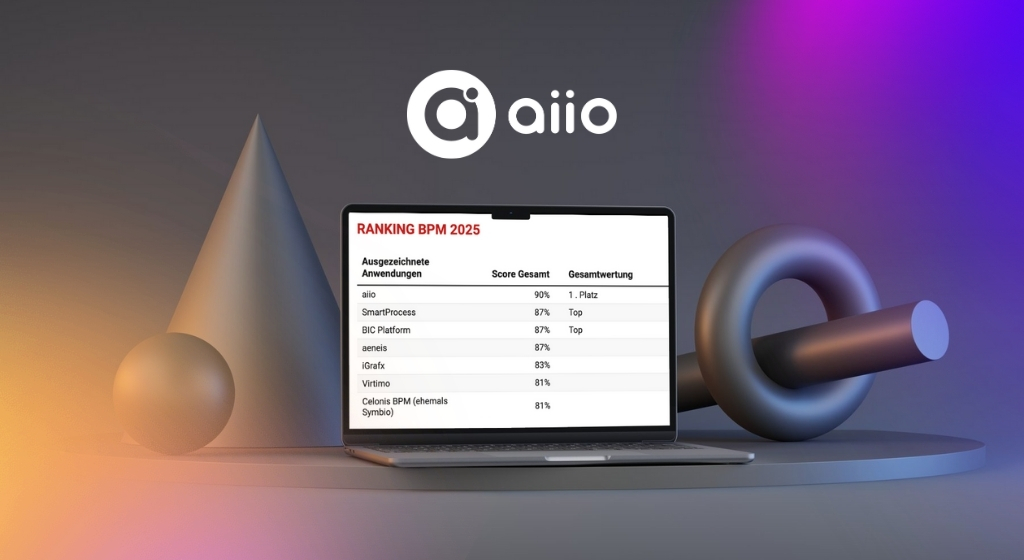From Lean to AI: The best methods for process optimization in the age of digitalization

Overview of traditional methods
Traditional process optimization methods have been used for decades and have proven themselves in many industries. One of the best-known methods is the Lean methodology, which aims to minimize waste and maximize value for the customer. The focus here is on the continuous improvement process (Kaizen), in which employees at all levels of the company are constantly looking for ways to improve processes.
Another crucial approach is Six Sigma, a methodology originally developed by Motorola. Six Sigma aims to minimize process errors and improve quality through the application of statistical tools and techniques. It follows a structured approach that is divided into the phases Define, Measure, Analyze, Improve and Control (DMAIC).
Modern approaches and their differences from traditional methods
While traditional methods such as Lean and Six Sigma are still relevant, modern approaches to process optimization have gained importance in recent years. In particular, the use of digital technologies and artificial intelligence is revolutionizing the way companies analyze and optimize their processes.
A central element of modern methods is data analysis. By collecting and analyzing large amounts of data, companies can gain deeper insights into their processes and identify more precise optimization measures. This is where artificial intelligence (AI) comes into play, which is able to recognize complex data patterns and make predictions about future process deviations.
Another difference is the integration of feedback from various stakeholder groups in real time. Modern tools like aiio enable not only management, but also employees, customers and suppliers to actively contribute to process optimization. This comprehensive integration ensures that optimization measures take all relevant perspectives into account and can therefore be implemented more sustainably.
While traditional methods are often designed for long-term, predictable changes, modern approaches allow for a more agile implementation. This means that adjustments can be made more quickly and their effects can be evaluated promptly. This enables companies to react more flexibly to market changes and new challenges.
Why the involvement of various stakeholders is crucial
Process optimization is rarely a one-man show. The involvement of various stakeholders in the company is essential in order to achieve sustainable and comprehensive improvements. Each stakeholder brings different perspectives, knowledge and experience that are valuable in order to view and optimize processes holistically. If all relevant parties are involved in the optimization process, not only does the probability of the measures being successful increase, but also that they are supported by all those involved.
Stakeholder involvement leads to greater acceptance and motivation. Employees who are actively involved in the optimization process feel valued and taken seriously. This is reflected in increased satisfaction and a stronger motivation to accept and implement new processes. Management also benefits: potential problems can be identified and resolved early on through direct feedback. Customers and suppliers who are involved in the process can provide valuable external perspectives that are often overlooked. This not only improves internal processes, but also optimizes collaboration along the entire value chain.
Examples of typical stakeholders in process optimization
- Employees: They know the daily routines better than anyone else and can contribute practical suggestions for improvement.
- Management: Is responsible for the strategic orientation and the implementation of the optimization measures.
- Customers: Their expectations and feedback are crucial in order to design processes in a customer-oriented manner.
- Suppliers: They play an important role in the supply chain and can point out optimization potential in procurement and logistics.
Examples of successful stakeholder involvement
A practical example of successful stakeholder involvement is the implementation of the "Obeya Room" from the Lean methodology. In this room, representatives from various departments come together regularly to jointly monitor the progress of improvement projects and discuss new ideas. Open and transparent communication promotes mutual understanding and facilitates the implementation of optimization measures.
Another example is the use of feedback loops. A company could conduct regular surveys and workshops to systematically collect feedback from employees and customers. This feedback is analyzed and used as the basis for continuous improvements. Through this systematic integration, companies can ensure that optimization measures are based on well-founded and diverse information.
The software aiio offers an integrated platform that makes it possible to collect and evaluate feedback from various stakeholders in real time. This promotes collaboration and ensures that all relevant perspectives are incorporated into the optimization process. This not only leads to innovative solutions, but also increases the acceptance and satisfaction of stakeholders.
How artificial intelligence complements traditional methods
Artificial intelligence has the potential to fundamentally change the way companies optimize their processes. While traditional methods are often based on retrospective data and human expertise, AI offers the possibility of analyzing large amounts of real-time data and making predictions from this data. This enables companies not only to improve existing processes, but also to proactively identify and address potential problems.
A key advantage of AI is its ability to recognize complex patterns that often remain invisible to the human observer. Through machine learning algorithms, AI can continuously learn from data and make increasingly precise optimization suggestions. These suggestions are based on well-founded analyses and have the potential to achieve significant efficiency gains and cost savings.
Special role of aiio and its functionalities
This is where aiio comes in - an advanced AI-supported tool for process optimization that enables companies to transform their operations from the ground up. By using AI, aiio offers a range of powerful functions that complement and surpass traditional methods:
- Stakeholder Involvement: aiio enables the collection and integration of real-time feedback from various stakeholders, such as employees, managers, customers, and suppliers. Seamless communication and collaboration ensure that all relevant perspectives are considered, leading to more comprehensive and sustainable optimization solutions.
- AI-Generated Suggestions: aiio analyzes massive amounts of data and identifies patterns and trends relevant to process optimization. Based on this, the tool provides AI-generated suggestions that help companies make their processes more efficient. These suggestions are data-driven and based on proven methods tailored specifically to the company's needs.
- Continuous Improvement: The adaptive learning capabilities of AI in aiio ensure that optimization suggestions are continuously improved. The more data the system processes, the more precise and valuable the suggestions become. This fosters a culture of continuous improvement, where processes are constantly monitored and optimized.
By combining human expertise and AI-powered analysis, aiio offers companies a powerful platform to maximize their operational efficiency.
AI in Process Optimization Practice: aiio at MEDIA Central
The successful implementation of aiio at MEDIA Central demonstrates that AI models have already arrived in process optimization practice: MEDIA Central is one of the earliest adopters of aiio and was convinced of aiio's mission from the start. Since the introduction of AI functionalities, MEDIA Central has been using precisely this function to continuously optimize processes more efficiently - with success.
Benefits and Advantages of AI-Powered Process Optimization
Efficiency Gains and Cost Reductions
The integration of AI into process optimization brings significant efficiency gains and cost reductions. By analyzing large amounts of data in real-time, AI can identify bottlenecks and inefficiencies early on and suggest optimization measures. This leads to a reduction in cycle times and an improvement in resource utilization. Companies can quickly react to market changes and continuously adapt their processes thanks to the responsiveness of AI.
A concrete example from practice shows that companies using AI-based process optimization can achieve an average reduction in production times of up to 20%. At the same time, optimized inventory and supply chain management algorithms enable a reduction in storage costs of up to 15% by avoiding overstocking and improving inventory turnover rates.
Quality Improvements and Flexibility
In addition to cost reductions, quality improvement also plays a central role in process optimization using AI. AI-powered systems can detect errors and deviations in processes early on, thus contributing to increasing product quality. Through continuous monitoring and analysis of quality data, companies can take proactive measures to avoid quality problems before they lead to costly recalls or complaints.
The flexibility gained through AI-based process optimization is another significant advantage. Companies can adapt their processes to changing conditions and requirements without the need for extensive restructuring. This is particularly beneficial in dynamic markets where rapid responses to changes are required.
For example, a production line equipped with AI technologies can quickly react to changing product specifications without major manual adjustments. This leads to increased productivity and better adaptability to customer wishes.
Summary of Benefits
The benefits of AI-powered process optimization are diverse and include:
- Significant reduction in production times and cycle times
- Cost reduction through optimized inventory management and process control
- Increase in product quality through early error detection and prevention measures
- Greater involvement and satisfaction of stakeholders through improved communication and collaboration
- Greater flexibility and adaptability to changing market conditions and customer requirements
Through these diverse benefits, companies can significantly increase their competitiveness and position themselves successfully in the market in the long term.
Conclusion
In a world that is constantly changing, process optimization is a crucial lever for keeping companies competitive and efficient. Traditional methods such as Lean and Six Sigma have proven their worth, but the integration of modern technologies, especially artificial intelligence, elevates process optimization to a completely new level.
By using AI-powered tools like aiio, companies can not only improve existing processes but also react proactively and dynamically to changes. The involvement of various stakeholders and the ability of AI to generate data-driven, precise suggestions lead to more comprehensive and sustainable optimization solutions. This is impressively demonstrated in the case study of an aiio customer who was able to achieve significant efficiency gains, cost reductions, and quality improvements through targeted measures.
The advantages of AI-powered process optimization are clear: efficiency gains and cost reductions go hand in hand with quality improvements and greater flexibility. Companies that exploit this potential not only improve their internal processes but also strengthen their position in the market.
Recommendations for Action and Outlook
- Capture and Analyze Data: Start by capturing and analyzing your process data to gain a clear understanding of current operations.
- Involve Stakeholders: Integrate all relevant stakeholders in the optimization process to gain different perspectives and valuable insights.
- Use AI Tools: Consider using AI-powered tools like aiio to receive optimization suggestions based on well-founded data analyses.
- Continuous Improvement: Implement a culture of continuous improvement, where processes are constantly monitored and adjusted.
With these steps, you can maximize the potential of process optimization and equip your company for the challenges of the future. The combination of traditional methods and modern technologies opens up completely new possibilities to operate more efficiently and flexibly.
In conclusion, it should be noted that the journey of process optimization is not a one-time project, but an ongoing process that constantly offers new opportunities and possibilities. By using AI and actively involving various stakeholders, you can ensure that your company not only keeps up, but takes the lead.
Don't hesitate, ask directly
Please use our contact form. Our team will get back to you as soon as possible.

.jpeg)



